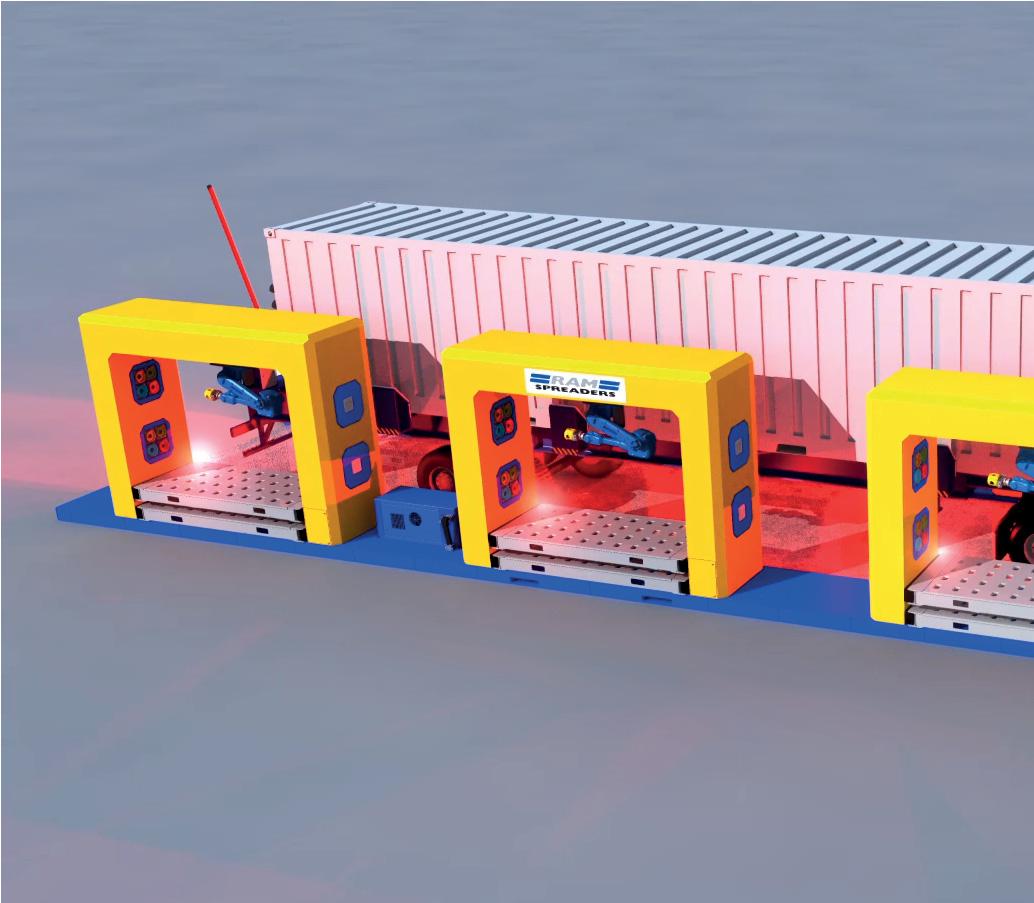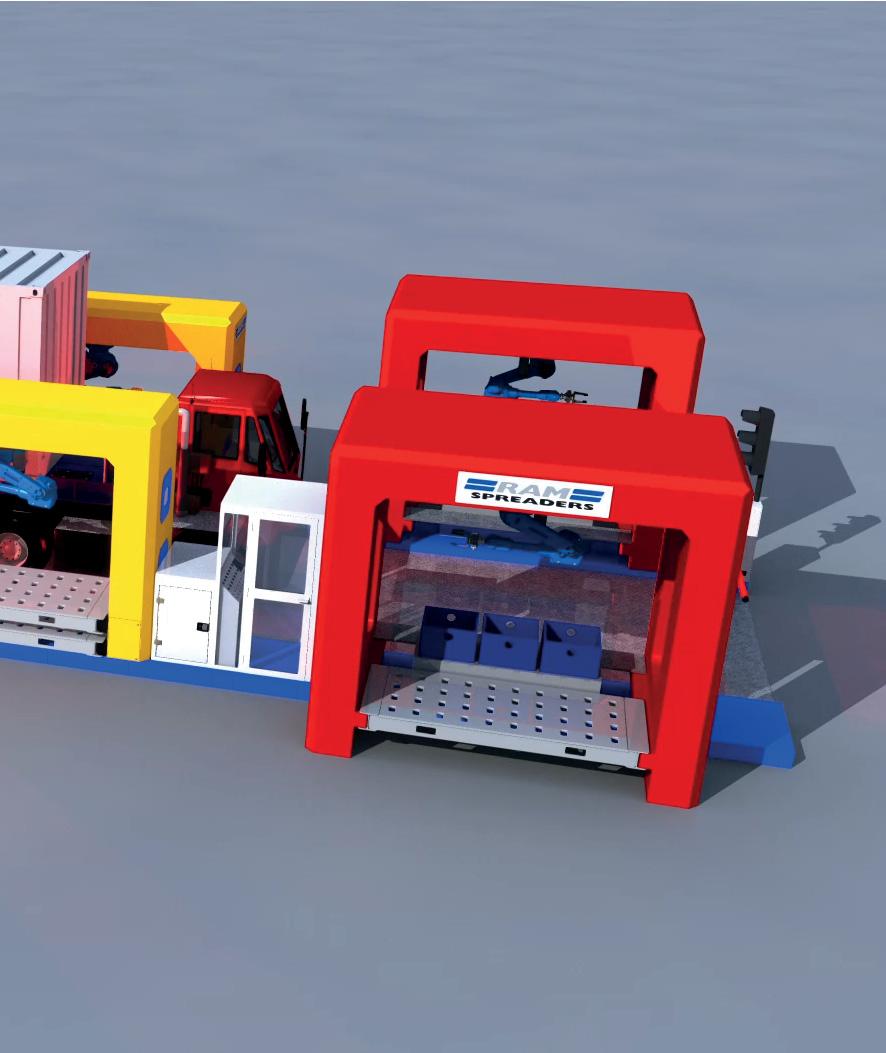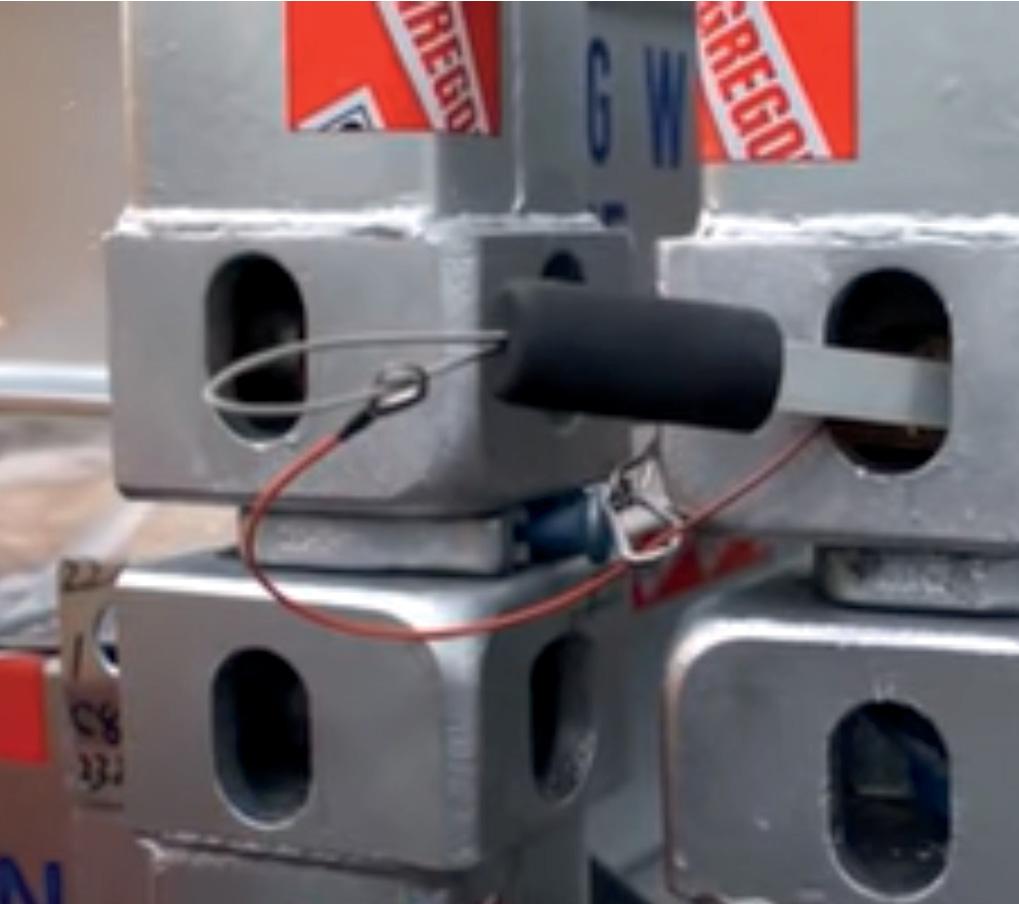
7 minute read
Auto twistlocks
AUTO’ TWISTLOCKS: BULL RUN?
John Bensalhia looks at the issues and potential benefi ts surrounding the use of fully automated twistlock and pinning solutions...


In theory, full automation in the world of pinning and twistlocks should present a golden opportunity to container handling concerns. In terms of effi ciency, safety and cost/ labour saving, fully automated pinning and twistlock handling provide the answers.
Manual pinning has been a necessary feature of container handling, with around two billion twistlocks handled manually every year. However, investment to optimise container flow becomes sustainable, and cargo handling systems, especially quay cranes, can yield unseen productivity levels if pinning is fully automated.
“Automated pinning removes a harsh, risky, and routine task in the container handling process, putting the industry in step with global progress towards better working methods and standards,” says Mani Chellappa, PinSmart Project Manager, RAM Spreaders.
“Since the early 2000s, port cranage and other systems have expanded in size and number rapidly to match the increasing size and capacities of mega-vessels, but pinning methods have remained largely unchanged. Manual pinning must be replaced if ports want maximum performance from modern machines.”
“Current quay crane hourly performance ranges, on average, between 25-35 moves per hour, a marginal improvement from the 1990’s average of between 25-30 moves per hour. This is in contrast to the 300 per cent increase in the average container vessel size.”
Chellappa contends that manual pinning is a direct cause of slowing down operations, taking a minute or more for each container lifting move. Automated pinning, therefore, will naturally speed up operations and allow terminals to reduce operational costs.
Insurance costs, he argues, will also be reduced by removing the dangers of manual pinning. “Current and future users of tandem lift operations to increase throughput by handling twin 40’ / 45’ or quad 20’ containers will experience faster cycle times by using a twin cradle PinSmart with four robots altogether reducing the pinning time from the cycle.”
THEORY INTO PRACTICE?
But in practice, is this automated solution favoured? A paper written by Michael Kugler and Marcus Brandenburg, entitled Analysis of Twistlock Handling Automation in Container Terminals, puts forward the view that automated twistlock handling systems have hardly been implemented. It suggests that automatic twistlock handling has hardly been adapted, with manual application still the main method used in container terminals.
Reasons given for this include technological, strategic and economic issues. Kugler and Brandenburg argue that money is required for maintenance, disturbances in port operations, and physical integration of automatic twistlock solutions in existing cranes.
The Barriers… …Mixed up twistlocks…
Chellappa says that a persistent factor that hinders pinning automation is the range of twistlocks. This is because twistlocks from discharge containers are frequently recycled for fixing in conjunction with a loading container. “When the sequence of moves starts with a loading cycle, twistlocks must be obtained from vessel bins containing different, even irrelevant, twistlocks.
“Twistlocks get mixed up over time between vessels that berth next to each other. The PinSmart Project Team envisages that this problem will be corrected over time, as ports can incentivise vessel masters’ co-operation to keep an organised inventory based on credible and proven automation.”
RAM’s revamped 2019 PinSmart can fix and remove a variety of twistlock types in quick succession with this proven
8 RAM’s fully
automated ‘wharf drive-thru pinning station’ off ers remote pinning operations away from quay cranes
in mock-up trials. “Each individual robot in PinSmart travels to all corners of a 20’ container and is capable of manipulating all present and future twistlock models.”
Since then, RAM has developed a fully automated ‘wharf drive-thru pinning station’ for ports that prefer remote pinning operations away from the space under the quay crane.
“The drive-thru pinning station is located at both ends of the berth’s crane group and removes congestion caused by pinning activity away from the working cranes. Consisting of pinning and sorting cells, each cell has a set of interchangeable tools and shape recognition technology to detect and install or remove twistlocks once the containerbearing trailer comes to a stop within the driveway.”
“The ‘Pinning cell’ robots work off storage cassettes that are filled with the correct type of twistlock by the ‘sorting cell’ robots. A much-reduced stevedoring workforce transfers the cassettes between the storage and pinning cells, and a separate depository for large vessel operations, using forklifts,” explains the company.
…Automation, exciting and worrying, and…
Another issue is that psychologically, automation tends to simultaneously excite and worry. “This is a problem for any industry willing to adopt new automated systems designed to improve operations and boost profits through productivity,” says Chellappa. “It is indeed a curious anomaly,” he continues, “that in the port industry, which has seen many innovations and technological changes to improve the efficiency of container handling operations, the important task of twistlock handling has not changed since the birth of containerisation in the mid-1950s. The fact remains that there has been a lack of comprehensive automation perpetuating resistance to the idea…”
…Job losses
The social issue of displacing jobs is another factor. Container lashing and pinning count as dangerous occupations, posing a daily risk of injury to quayside workers. Chellappa says that decision-makers must consider that prime movers in other industries with similar risk levels would be held to account for allowing the continuation of an archaic practice due to social pressure and to the detriment of worker safety.
“The initial dislocation of workers is an inevitable price for removing the dangers away from the quayside,” Chellappa states. “History has shown that higher value and different jobs are created to offset those lost beyond the adjustment period.”
MORE INTEREST
Despite these latter negatives, however, the other side of the argument is that automated techniques in this field are garnering more interest.
With respect to recent sales, Chellappa says that several container terminals have shown interest in PinSmart. “This interest,” he elaborates, “will likely increase in the coming months, given worsening port congestion, labour immobility, and shortage. In this dire situation, automated pinning will help terminals increase their throughput, alleviate congestion, and bring down freight costs to a satisfactory level within a year or two of implementation as the environment needs to adapt to the new technology.”
OTHER SOLUTIONS
Other manufacturers have come up with automated solutions. Container Quick Lock’s self-closing system, for example, comprises two aspects: the adapter (which is welded to the trailer) and the locking system (which is put in the adapter). Capable of locking containers onto a trailer, the Quick Lock system has been designed to ensure that potential unlocking of a container is impossible, protecting cargo against possible vibrations, dislodging or theft.
Quick Lock is designed with the driver’s ease of use in mind. A driver can easily and quickly lock at the press of a button without having to exit the cab during loading/ unloading. Quick locking saves a time span that exceeds 10 minutes for locking and unlocking.


8 The MacGregor
C8A fully automatic dual-function twistlock is said to maximise safe operations
A veteran of the automatic twistlock world is the MacGregor C8A fully automatic dual-function twistlock. As an alternative to manual twistlock application, the C8A is designed for improving both safety and performance levels during cargo container handling. In terms of performance, the time rate is reduced from 20 seconds to virtually zero.
SAFETY FOCUS
Safety is highlighted as a major benefit of automated solutions.
From a safety angle, the MacGregor C8A enables stevedores to work from a distance away from heavy equipment or cargo during lifting.
Chellappa says that pinning operations in container handling represent a textbook opportunity for automation.
“The situation is now more pressing as ports accommodate larger vessels and need to handle more containers in a shorter time, turning around ships faster to compete. Ports are also under pressure to make the wharf a safe environment and secure from unauthorised access. The introduction of available technology such as PinSmart is the definitive holistic solution, especially when tandem lift operations become the new norm in container handling.”
Safety is also a defining facet of SEC Bremen’s heavy duty fully automatic twistlock. Its breaking load is doubled at a minimum of 1000 kN, exceeding the highest levels of safety standards. Safe locking is guaranteed against lifting forces during a voyage, and with extra strength in mind, the SEC Bremen automatic twistlock is made from materials such as high tensile cast steel.










